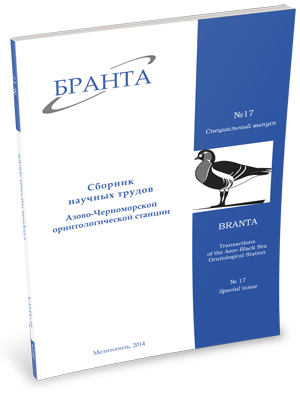
Transactions
of the Azov-Black Sea Ornithological Station



Bird seasonal features of territory Botievo wind farm based on observation spring 2013-2014
P. I. Gorlov, V. D. Siokhin, V. I. Dolynny, A. I. Sidorenko
The studies were conducted in Zaporizhia region at the Botiyevo wind farm and in the adjacent wetlands. The expeditions were carried out in spring 2013 and 2014. During 36 days (217 hours) the information has been collecting at the observation points. The car counts had the length of 505 km, 2 cars and 3 observers were involved. In the spring season 229 species of birds were marked in the region according to the retrospective and current data. 115 species of them were registered at the Botiyevo wind farm. But in 2013-2014 only 63 species were recorded. In 2013 the total number of birds (52 species) consisted of 19741 inds., 7921 inds. of them (40.1%) were at the Botiyevo wind farm and 11820 inds. (59.9%) in the adjacent areas of high biodiversity (Botiyevo ponds and Tubalskyy Liman). In 2014 the total number of birds (52 species, too) consisted of 10572 inds., 6708 inds. of them (63.5%) were observed at the Botiyevo wind farm and 3867 inds. (36.5%) in the adjacent wetlands. The most numerous birds were Ruff, Rook and Mediterranean Gull. Ruff, Garganey and Shelduck dominated on the Tubalskyy Liman and Botiyevo ponds. The diversity of birds is characterized by 27-37 species registered at the wind farm area and 32-34 species in the adjacent wetlands. In March 2013 and 2014 the north, northeast and northwest directions of migration prevailed. In these directions 80.4% of birds in 2013 and 63.4% in 2014 were registered. In April 2013 about 94% of the birds migrated in south-west direction which was untypical for transit migrants. In 2014 79.2% of the birds were flying in the north, north-east and east directions. Most of the birds (about 98%) were flying at the altitude up to 50 m which is safe for them. The new method of the assessment of the impact on birds was applied. The results of the assessment allow to affirm that the level of negative impact of the wind farm on birds is low.
Read the paper in a PDF file